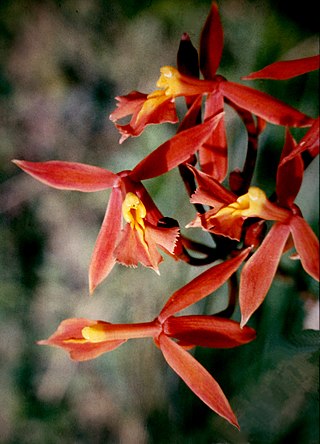
Orchids are plants that belong to the family Orchidaceae, a diverse and widespread group of flowering plants with blooms that are often colourful and fragrant. Orchids are cosmopolitan plants that are found in almost every habitat on Earth except glaciers. The world's richest diversity of orchid genera and species is found in the tropics.

Bulbophyllum is a genus of mostly epiphytic and lithophytic orchids in the family Orchidaceae. It is the largest genus in the orchid family and one of the largest genera of flowering plants with more than 2,000 species, exceeded in number only by Astragalus. These orchids are found in diverse habitats throughout most of the warmer parts of the world including Africa, southern Asia, Latin America, the West Indies, and various islands in the Indian and Pacific Oceans. Orchids in this genus have thread-like or fibrous roots that creep over the surface of trees or rocks or hang from branches. The stem is divided into a rhizome and a pseudobulb, a feature that distinguished this genus from Dendrobium. There is usually only a single leaf at the top of the pseudobulb and from one to many flowers are arranged along an unbranched flowering stem that arises from the base of the pseudobulb. Several attempts have been made to separate Bulbophyllum into smaller genera, but most have not been accepted by the World Checklist of Selected Plant Families.

The Pleurothallidinae are a neotropical subtribe of plants of the orchid family (Orchidaceae) including 29 genera in more than 4000 species.

Cypripedioideae is a subfamily of orchids commonly known as lady's slipper orchids, lady slipper orchids or slipper orchids. Cypripedioideae includes the genera Cypripedium, Mexipedium, Paphiopedilum, Phragmipedium and Selenipedium. They are characterised by the slipper-shaped pouches of the flowers – the pouch traps insects so they are forced to climb up past the staminode, behind which they collect or deposit pollinia, thus fertilizing the flower. There are approximately 165 species in the subfamily.

Epidendroideae is a subfamily of plants in the orchid family, Orchidaceae. Epidendroideae is larger than all the other orchid subfamilies together, comprising more than 15,000 species in 576 genera. Most epidendroid orchids are tropical epiphytes, typically with pseudobulbs. There are, however, some terrestrials such as Epipactis and even a few myco-heterotrophs, which are parasitic upon mycorrhizal fungi.

Dactylostalix is a genus of flowering plants from the orchid family, Orchidaceae. At the present time, there is only one known species, Dactylostalix ringens. It is native to Japan, the Kuril Islands, and Sakhalin Island.
Didymoplexiella is a genus of flowering plants from the orchid family, Orchidaceae. It contains 8 known species native to Southeast Asia, with a few species extending northwards into Japan and southern China. These are mycoheterotropic plants lacking chlorophyll, obtaining nutrients from fungi in the soil.
- Didymoplexiella borneensis(Schltr.) Garay - Sarawak
- Didymoplexiella cinnabarinaTsukaya, M.Nakajima & H.Okada - Kalimantan
- Didymoplexiella denticulataAver. - Laos, Vietnam
- Didymoplexiella forcipata(J.J.Sm.) Garay - Kalimantan
- Didymoplexiella kinabaluensis(Carr) Seidenf. - Sabah
- Didymoplexiella ornata(Ridl.) Garay - Thailand, Vietnam, Malaysia, Borneo, Sumatra
- Didymoplexiella siamensis(Rolfe ex Downie) Seidenf. - Hainan, Taiwan, Japan, Ryukyu Islands, Thailand, Vietnam
- Didymoplexiella trichechus(J.J.Sm.) Garay - Sumatra, Bangka

Zelenkoa is a genus of flowering plants from the orchid family, Orchidaceae. It contains only one known species, Zelenkoa onusta, native to Ecuador and Peru.

Trizeuxis is a monotypic genus of flowering plants from the orchid family, Orchidaceae. The sole species is Trizeuxis falcata, native to the American Tropics.

Traunsteinera, the round headed orchid, or globe orchid, is a genus of flowering plants from the orchid family, Orchidaceae.
Ischnogyne is a genus of flowering plants from the orchid family, Orchidaceae. It contains only one known species, Ischnogyne mandarinorum, native to China.

Taprobanea is a genus of flowering plants from the orchid family, Orchidaceae. There is only one known species, Taprobanea spathulata, native to India and to Sri Lanka.

Nidema is a genus of flowering plants from the orchid family, Orchidaceae. It contains two known species, both native to the tropical Western Hemisphere.
Nohawilliamsia is a genus of flowering plants from the orchid family, Orchidaceae. Only one species is recognized as of June 2014, Nohawilliamsia pirarensis, native to northern South America.
Phragmorchis is a monotypic genus of flowering plants from the orchid family, Orchidaceae. The sole species is Phragmorchis teretifolia, endemic to the Island of Luzon in the Philippines.
Sauroglossum is a genus of flowering plants from the orchid family, Orchidaceae. The genus is endemic to South America. As of June 2014, the following species are recognized:
- Sauroglossum andinum(Hauman) Garay - Ecuador, Argentina
- Sauroglossum aurantiacum(C.Schweinf.) Garay - Peru
- Sauroglossum corymbosum(Lindl.) Garay - Peru, Bolivia
- Sauroglossum distansLindl. ex Garay - Bolivia
- Sauroglossum dromadumSzlach. - Peru
- Sauroglossum elatumLindl - Ecuador, Argentina, Colombia, Brazil
- Sauroglossum longiflorum(Schltr.) Garay - Ecuador, Colombia
- Sauroglossum odoratumRobatsch - Rio de Janeiro
- Sauroglossum organenseSzlach. - Rio de Janeiro
- Sauroglossum schweinfurthianumGaray - Peru
- Sauroglossum sellilabre(Griseb.) Schltr. - Paraguay, Argentina

Seidenfadenia is a genus of flowering plants from the orchid family, Orchidaceae.
Sphyrarhynchus is a monotypic genus of flowering plants from the orchid family, Orchidaceae. The sole species is Sphyrarhynchus schliebenii, endemic to Tanzania.
Systeloglossum is a genus of flowering plants from the orchid family, Orchidaceae. It contains 5 known species, all native to southeastern Central America and northwestern South America.
- Systeloglossum acuminatumAmes & C.Schweinf. - Costa Rica, Panama
- Systeloglossum bennettii(Garay) Dressler & N.H.Williams - Peru
- Systeloglossum costaricenseSchltr. - Peru
- Systeloglossum ecuadorense(Garay) Dressler & N.H.Williams - Ecuador
- Systeloglossum panamenseDressler & N.H.Williams - Panama

Dendrobieae is a tribe in the subfamily Epidendroideae, in the family Orchidaceae. The Dendrobieae are mostly tropical, epiphytic orchids which contain pseudobulbs.













